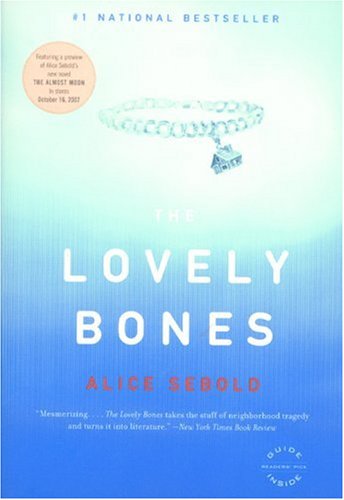All Nonfiction
- Bullying
- Books
- Academic
- Author Interviews
- Celebrity interviews
- College Articles
- College Essays
- Educator of the Year
- Heroes
- Interviews
- Memoir
- Personal Experience
- Sports
- Travel & Culture
All Opinions
- Bullying
- Current Events / Politics
- Discrimination
- Drugs / Alcohol / Smoking
- Entertainment / Celebrities
- Environment
- Love / Relationships
- Movies / Music / TV
- Pop Culture / Trends
- School / College
- Social Issues / Civics
- Spirituality / Religion
- Sports / Hobbies
All Hot Topics
- Bullying
- Community Service
- Environment
- Health
- Letters to the Editor
- Pride & Prejudice
- What Matters
- Back
Summer Guide
- Program Links
- Program Reviews
- Back
College Guide
- College Links
- College Reviews
- College Essays
- College Articles
- Back
The Lovely Bones by Alice Sebold
The Lovely Bones
Murder, rape, and pain are not the first words that usually come to mind when one thinks about beautiful literature. However, Alice Sebold, the author of The Lovely Bones, along with Lucky and The Almost Moon, manages to twist these gruesome topics into a masterpiece—complete with passion and an underlying message of acceptance. The story of Susie Salmon is one that reaches out to anyone who has struggled in their life and offers a piece of mind—a comfort. The message, craftsmanship and poignant nature of The Lovely Bones sets it apart as a must read novel.
From the very beginning, the reader is introduced to the dynamic mind of 14 year old Susie Salmon, a victim of rape and murder. Sebold is able to speak vividly and assertively about the world as Susie sees due to personal experiences. While attending Syracuse, Sebold had also fallen victim to the tragedy of rape. This insight allows her to accurately describe Susie’s emotions and create a vibrant world of sensation for her readers. The book is written similarly to The Catcher in the Rye, in that the reader sees the world through the eyes of the main character. Before being killed, Susie remarks, “I did not realize then that I was an animal already dying.” Such use of imagery and figurative language is included throughout the piece, enhancing the reader’s enjoyment and connection to the characters.
Another distinctive aspect of the novel is the way the plot shifts between Susie’s picturesque heaven and her family coping back on earth. Although it can be irritating at times to switch back and forth, this clever structure allows the reader to experience both Susie’s pain and that of her loved ones. As Susie watches life below move on without her, her family struggles to find the sly man who killed her. While Sebold’s diction is that of a young girl—rather ordinary—it works well in the book, because it is as if Susie is speaking directly to you. The greatest strength of the piece lies in Sebold’s unique ability to keep the reader itching to know what happens next. Ending each section with a cliff hanger establishes a sense of anticipation and a desire to flip the page. Sebold also utilizes the structure of her work to symbolize Susie’s maturation while in heaven. The novel gradually shifts its focus from Susie’s wish to catch her rapist, Mr. Harvey, to focusing on her desire to see her family happy. Sebold’s development of Susie’s character reveals a new twist on a coming-of -age story.
Perhaps the most intriguing and relatable aspect of this piece is the infusion of real life struggles. Sebold writes that “horror on Earth is real and it is every day...it cannot be contained.” Susie’s mother, Abigail, experiences this horror as she slowly separates herself from her husband and the rest of the family. Lindsey, Susie’s sister, also wades in deep agony as she resembles Susie to a point that her own identity is lost. Lastly, Buckley, the youngest child is lost in a sea of confusion as he is too young to comprehend the situation. Sebold appeals to her audience emotionally by discussing how the actions of each family member and those such as Ray, Susie’s crush, directly affect Susie—begging the reader to think about how their own actions affect those that they love.
As an accomplished author and winner of the Bram Stoker Award for this piece, Sebold was able to incorporate a meaningful lesson into her story. Trapped behind a glass wall between heaven and Earth, Susie must ask herself if she is “done yearning for [her family], needing them to yearn for [her]”. We’ve all wanted something that is just out of reach, and Susie’s revelations throughout the book demonstrate that although things may not work out as we expected, everything happens for a reason. It’s antagonizing that the story doesn’t come together until the very end, but after finishing the book with tears in my eyes, I can tell you the ending is unexpected and well worth the wait.
Filled with suspense, heart throbbing emotions, and real life lessons, The Lovely Bones exemplifies well executed literature. Alice Sebold’s writing is honest; she is not afraid to push the envelope and talk about sensitive topics. Through the flashbacks and metaphors of the book, the reader is transported into the center of the action. Susie Salmon represents all of us, facing hardships, growing mentally and emotionally—whether we’re ready for it or not. If you are looking for a page turner, a book that will get you thinking, The Lovely Bones is the perfect choice. I guarantee that the only disappointment you will encounter in the novel is that it has to eventually come to an end.
Similar Articles
JOIN THE DISCUSSION
This article has 0 comments.

